1) SSSL (Single Sided, Single Layer) disc and DVD5 (D5 for short)
DVD and CD are almost the same on surface, but they are difference inside. Assembled by single side/double side and single layer/double layer, DVD can be divided in to four basic physical structures: single side single layer, single side double layers, double-side, single-layer, double-side double layers. Single-sided DVD disc may have one or two recording layer. Like with the CD, CD-ROM laser from reading the following data on a single disc, double-sided DVD, the data were stored in the disc up and down both sides.This refers to the common single-sided single-layer DVD discs, with a total capacity of 4.7GB, can store 133 minutes of video data.
Single-sided single-layer DVD disc is a blank substrate and a data recording layer of the substrate bonding layer formed. Both single-layer disc or a dual-layer disc by bonding two substrates made of the thickness of the substrate per tablet are 0.6mm, so DVD disc thickness 1.2mm.
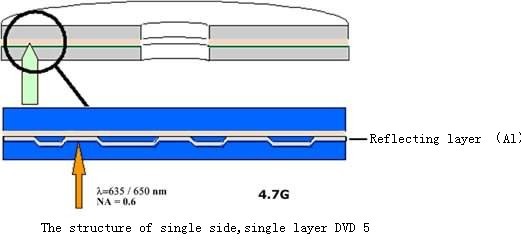
2) DSSL (Double Sided, Single Layer) Discs DVD10 (D10 for short)
This refers to the double-sided single-layer DVD disc which is 0.6 mm thick on both sides of each layer of recording layer of the substrate bonding formed, with a total capacity of 9.4GB, can store about playing 266 minutes of video data.To read the data on double-sided disc, there are two methods:
(1) finished playing the first side of the plate program, it will remove the disc from the player, upside down and then into the players continue to play second surface of the program;
(2) players Zhongzhuang two read lasers, respectively, from the disk to read data up and down both sides, or players, only installed a read laser, but read the disc after the first plane can automatically jump to the disc The other side continues to play.
If we use the second method, users shall need not to get out the disc and turn it over, but the DVD player should have this function.
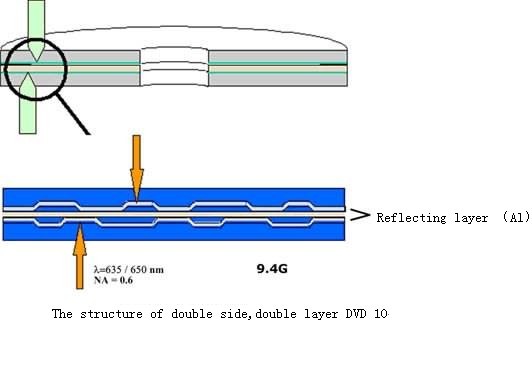
3) SSDL (Single Sided, Double Layer) discs DVD9 (D9 for short)
It refers to single-side, double-layer DVD discs with a total capacity of 8.54 GB, which can store and play video data of 241 minutes.Double layer disc has two solutions, one is to set a piece of film base with two recording layers, and the other film base is a blank one. Then stick them together. Such solutions in the actual production process requirements due to high yield with low rather than be used. Another approach would be two separate recording layers on the bottom two pieces under the base, the recording layer made of the following translucent layer, the above recording layer made of reflective layer, and then bonding the two pieces under the base. This is currently widely used DVD-9 program.
When the laser head reads double layer CD, the layer head shall first go to the lower recording layer that is called 0 layer (L0,layer 0), here the laser head is able to read data for this layer is reflecting layer. Meanwhile, the laser head can also read the upper layer (1 layer, reflecting layer, L1, Layer 1). So the layer 0 is a semi transparent layer that is also called Semi-reflective layer. The read of layer 0 starts from the inner side to the outer side. The laser head shall first read the layer 0 then the layer 1.
There are two methods in reading layer 1:
(1) OTP (Opposite Optical track Path) that is to read the layer1 from the outer side rings and from the outer rings to the inner rings.
(2) PTP (Parallel Optical track Path) That is to read the first layer from the inner side and then move outwards.
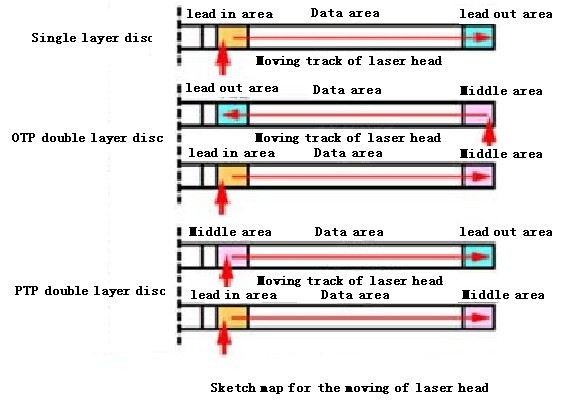
PTP has the same recording layer and the same grooves with that of single layer CD, while the OPTP has the opposite groove rail in layer 1.
OPT Double layer disc is also called RSDL (Reverse Spiral Dual Layer). While making this double layer DVD discs, we can select OPT or PTP and write in the commands at the end of data on the layer 0. According to this commands, the mother disc burning equipment will be automatically required burning second floor master disk. CD-ROM not only reads data, but also in accordance with this directive uses backlighting, or shuns the path way to read an optical path layer data. Reading laser head reading the 0.1 level data, the optical focus would be changed. With cis-optical path, the laser head needs to return to the outer ring inner ring, in the video when you play there will be a small pause, therefore, manufacturers generally prefer to use backlighting path OTP way.
The capacity of double layer disc is a little bit smaller than two times as that of single layer discs. This is because the laser beam shall go through the reflective layer to read the data on the upper layer, while the two recording layers have a small interval about 20-70 um. In order to reduce interference between the two layers, two layers of the minimum pit length of the light from 0.4 um to 0.44 um. To make up for it, the reference scanning speed should be faster, that is to improve the speed from 3.49m/s to 3.84 m/s. For the longer light pit, the intervals shall be longer to ensure the proper read of data and remove the influence of shock. Increase the minimum pit length of the light means that every ring of light reduces the number of pits, resulting in reduced capacity of each layer of data.
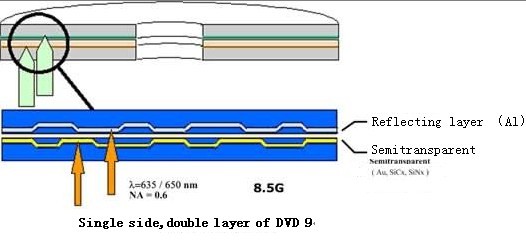
4) DSDL (Double Sided, Double Layer) Disc DVD18 (D18 for short)
This refers to the double layer, double side DVD discs with a total capacity of 17 GB, which can store a video data that can be played for 482 minutes.The double side, double layer disc is composed by two film bases with recording layers sticking together. The production of this Disc has a high requirement on technique; this means a higher producing cost. So the common manufacturer shall not use DVD-18 format if no further requirements. Actually, DVD-18 discs are rare in market.
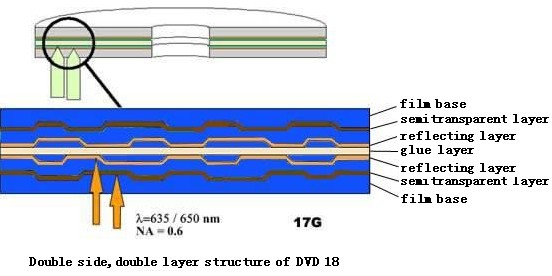
No comments:
Post a Comment